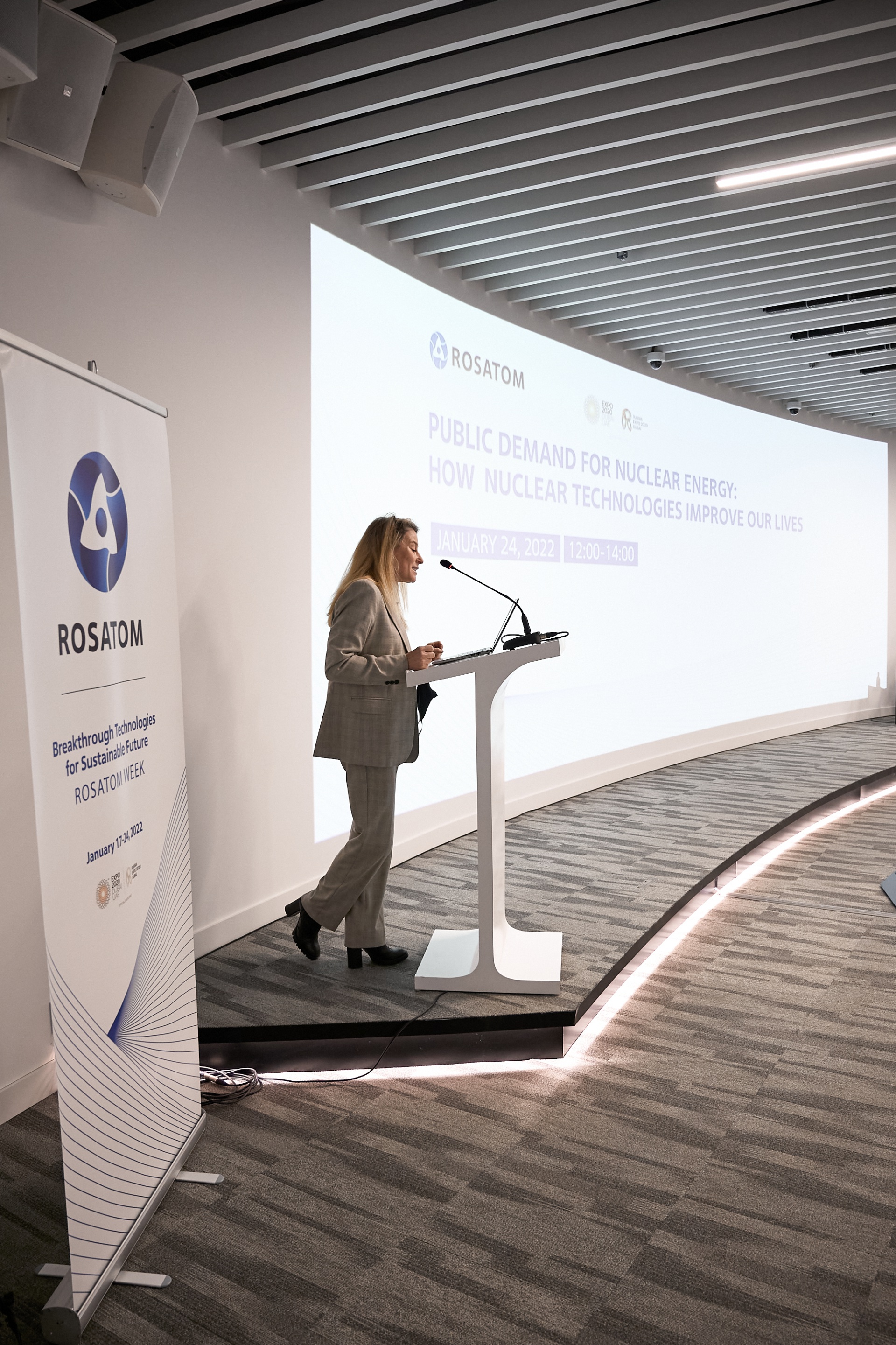On 24 January 2022, Rosatom hosted ‘Public demand for nuclear energy: how nuclear technologies improve our lives’, a strategic session that took place as part of Rosatom Week at Expo 2020 in Dubai. Alexander Voronkov, CEO of Rosatom Middle East and North Africa, moderated the session.
Public acceptance of nuclear energy was the focus of the discussion. As Mr Voronkov said: “Transparency and open dialogue are the beacons of effective communication in the nuclear sector. They ensure that correct information about sensitive topics is delivered and that common myths and stereotypes about nuclear energy are debunked. Moreover, they help win public trust.”
During the session, distinguished speakers from all over the world talked about global communication approaches for raising awareness about nuclear technologies, as well as the challenges that need to be overcome.
Sama Bilbao-y-Leon, the Director General of the World Nuclear Association, kicked off the discussion. She mentioned that access to reliable and clean electricity plays an important role in strengthening public health both directly and indirectly. “It goes beyond medical facilities; it includes protecting children’s lives, providing safe drinking water and food security,” said Bilbao-y-Leon.

The second speaker was Jeffrey Donovan, a Communication, Outreach and Stakeholder Involvement Officer at the International Atomic Energy Agency (IAEA). Mr. Donovan talked about a new guide published by the IAEA, which provides theoretical and practical advice on how to effectively engage stakeholders on nuclear topics. This speech was followed by a presentation from Cristian Vega, Vice President of the International Youth Nuclear Association, who described the main challenges of the 21st century, gave possible solutions and explained the role international organisations can play in improving people’s lives with the help of nuclear energy.
Ryan Collyer, CEO of Rosatom Central and South Africa, pointed out that one of Rosatom’s key goals is to motivate young people to educate themselves, their peers and their elders on the benefits of nuclear technologies and at the same time to come up with solutions to help their communities and countries. “Rosatom strongly believes that young people need to play a vital role in achieving the United Nations Sustainable Development Goals and more specifically in the fight against climate change. We put a great deal of resources into supporting youth to foster their talents and share their views and ideas,” said Mr. Collyer.
This focus on youth is why Rosatom organises an annual video competition called Atoms Empowering Africa, where young people from the age of 18 can share their videos and talk about how nuclear energy can benefit their lives and society at large. Gaopalelwe Santswere, President of the African Young Generation in Nuclear (AYGN) supports the initiative: “Video competition is a creative way to show that nuclear technology can provide innovative solutions to global challenges and create ways to benefit people’s quality of life on our continent.”
The Expo event also facilitated communication with young nuclear specialists, including Princess Mthombeni, an award-winning international communication specialist, founder of Africa4Nuclear and lifelong nuclear technology advocate. She mentioned the importance of engaging audiences across social media platforms to help spread powerful messages about the benefits of nuclear technology. Ms Mthombeni also told the audience about her successful media event – Stand up for Nuclear – which encouraged other countries, including Nigeria and Kenya, to join the nuclear debate.
Throughout Rosatom Week, international experts spoke at length about the benefits of nuclear technology. Many real-life examples were also shared to illustrate how nuclear technology can improve quality of life and bring lasting benefits to society. One of the most inspiring examples is The Rhisotope Project, an initiative between South Africa’s WITS University, top global nuclear scientists, researchers, South African rhino owners and the world’s best wildlife veterinarians aimed at significantly reducing rhino poaching. The purpose of the project was to create a lasting and effective means of lowering the amount of rhinos being poached for their horns by using radioactive isotopes.
During the Expo session, Ryan Collyer shared his personal view of the project: “The plight of the African rhino is a very serious one and the problem has been there for a long time. I think that every South African to one degree or another understands the problem. Sadly, we have now reached the point when there are only about 16,000 rhinos left in South Africa and that is the largest population in the world. I think that for me and for many others, this is a realisation that we are at this crucial point and we clearly haven’t done enough. We now need to take drastic measures to try to save them. This is really how the idea of The Rhisotope Project came to be. Basically, we are trying to save a magical and endangered species. If you look at a rhinoceros, it really is a real-life unicorn”.
The last speech was by Heather Hoff, one of the co-founders of Mothers for Nuclear. She started Mothers for Nuclear as a way to share the stories of women and begin a dialogue with others who want to protect nature for future generations.
To conclude the event, participants had an opportunity to see a video by Bálint Vincze, a typographer at the Paks nuclear power plant. Mr Vincze works on Atoms for Humanity, an initiative aimed at capturing people from all over the world sharing how nuclear transforms their lives and helps fulfil dreams, both big and small. Storytelling about nuclear energy through photography is a great example of how science and art can come together to achieve the same goal.
